Abstract
Background:
Postoperative complications are related to the surgical procedures, of failures of initial bladder closure and influence the urological, aesthetical and orthopaedic outcomes.
Materials and Methods:
We reviewed four patients who underwent complex bladder exstrophy-epispadias repair over a period of 14 years. The outcomes of treatment were assessed using, aesthetic, urological and orthopaedic examination data. Orthopaedic complications were explored by a radiography of the pelvis.
Results:
Out of four patients who underwent bladder exstrophy surgical management, aesthetic, functional outcomes and complications in the short and long follow-up were achieved in three patients. The first patient is a male and had a good penis aspect. He has a normal erection during micturition with a good jet miction. He has a moderate urinary incontinence, which requires diaper. In the erection, his penis-measures 4 cm long and 3 cm as circumference. The second patient was a female. She had an unsightly appearance of the female external genitalia with bipartite clitoris. Urinary continence could not be assessed; she did not have the age of cleanness yet. The third patient had a significant urinary leakage due to the failure of the epispadias repair. He has a limp, a pelvic obliquity, varus and internal rotation of the femoral head. He has an inequality of limbs length. Pelvis radiograph shows the right osteotomy through the ilium bone, the left osteotomy through the hip joint at the acetabular roof.
Conclusion:
When, the epispadias repair is performed contemporary to initial bladder closure, its success is decisive for urinary continence. In the female, surgical revision is required after the initial bladder closure for an aesthetic appearance to the external genitalia. Innominate osteotomy must be performed with brilliancy amplifier to avoid osteotomy through to the hip joint to prevent inequality in leg length.
Keywords: Bladder exstrophy, complications, epispadias, outcomes, surgery
INTRODUCTION
The success of bladder exstrophy surgery is evaluated from orthopaedic, genital, urinary and aesthetics outcomes. In the short term follow-up, postoperative complications such as failure of bladder closure or failure of bladder neck reconstruction can compromise early and long term outcomes. Various long term outcomes are described. Then, patients who underwent pelvic osteotomy for bladder exstrophy suffered more from hip pains, suggesting that pelvic osteotomy is indicated mainly when primary closure is either impossible or fails in bladder exstrophy reconstruction.[1] Bladder exstrophy has a detrimental psychological impact on women, fertility is impaired in women with bladder exstrophy. Pregnancy is highly risky both for the mother and the baby.[2] Sexual function in males was significantly affected across all dimensions, with mild to moderate dysfunction.[3] Urinary continence depends on various factors, successful initial bladder and posterior urethral closure is the single most important step to achieve urinary continence.[4] Best outcomes were achieved using lower extremity traction (with or without external fixation of the pelvis.[5]
Postoperative complications of bladder exstrophy management are orthopedic, urological and genital.[6,7] These complications are related to the surgical procedures, of failures of initial bladder closure. The psychological and-social impact of this condition often requires an evaluation of its effect on the quality of life of parents and children.[8,9]
We operated four cases of bladder exstrophy, three had posterior osteotomy and one had anterior innominate osteotomy. Some of them had an uneventful postoperative recovery, others presented postoperative complications with recovery after surgical revision. In this study, we are presenting the aesthetical, urological, orthopaedic and genitals outcomes.
PATIENTS AND METHODS
We reviewed four patients who underwent complex bladder exstrophy-epispadias repair over a period of 14 years. The study included the cases performed by one surgeon. Two patients underwent the initial bladder repair before 1-month age respectively at the 16th and 19th day and two others at the 19th month and 7 years- to 5 and 5 months.
All patients had the same surgical procedure of bladder closure in four steps:
Pelvic osteotomy
Posterior pelvic osteotomy: Three patients had posterior pelvic osteotomy.
Anterior innominate osteotomy: One patient had anterior innominate osteotomy
Anterior innominate osteotomy was indicated because of his age: He was 7 years- to 5 and 5- months old. The osteotomy was performed without brilliancy amplifier.
Bladder closure
Bladder closure was performed in three layers with polydioxanone 4/0 (PDS® 4/0 Ethicon Johnson & Johnson New Brunswick, NJ, United States). The bladder was repaired leaving the urethral stent, and ureteral stents for full urinary drainage.
Epispadias repair
Epispadias repair was performed with the initial bladder repair and included urethroplasty with repair of the dorsal curvature of the penis. The corpus cavernosum was completely detached from the spongiosum body and urethroplasty was performed on the urethral catheter with polydioxanone 6/0.
The bladder closure and epispadias repair were performed over ureteral stents and a urethral stent. All patients underwent modified Cantwell-Ransley epispadias repair.
Osteotomies stabilisation and immobilisation
All the patients had an orthopedic immobilisation and pelvic osteotomies stabilisation.
Three patients with posterior osteotomy had Bryant's traction and the last patient who underwent the anterior innominate osteotomy had an immobilization with a Batchelor's type plaster.
Postoperative cares
The prevention of postoperative infection was done with metronidazol and ceftriaxon. Pain was treated with paracetamol. The ureteral catheters were removed on the 10th postoperative day. Bryant's tractions were maintained for 3 weeks after bladder closure. Batchelor's type-plaster was removed 6 weeks after surgery.
The functional, orthopaedic, urological, genital, outcomes and quality of life were assessed during postoperative external follow-up of patients. Genital results were based on the aesthetic appearance, the existence of erection, and the measurement the dimensions of penis in males. Urological outcomes were explored by urinary continence, the Urine culture and computed tomography urography to assess the upper urinary tract.
Orthopaedic assessment was done with clinical examination. Radiograph of the pelvis was performed to explore the complications of pelvic osteotomy. The mean follow-up was 47 months and ranged from 5 months to 14 years.
RESULTS
Out of four patients who underwent bladder exstrophy surgical management, aesthetic, functional outcomes and complications in the short and long follow-up were achieved in three patients.
In the first patient, surgery was performed in the neonatal period. He underwent posterior pelvic osteotomy. After the initial bladder closure had failed, revision surgery was successful. He is now 14-years old.
He has a good penis aspect. He has a normal erection during micturition with a good jet miction. He has a moderate urinary incontinence which requires diaper.In the erection, his penis-measures 4 cm long and 3 cm as circumference [Figures 1 and 2]. CT urography carried out for exploring the urinary tract revealed no anomaly in upper urinary tract. Urine remained sterile on several cytobacteriological urinalyses. He had a normal biological renal function. Voiding cysturethrogram performed does not show vesico ureteral reflux. He had a normal gait. He had a good social and academic integration. He is a student in Junior High school and he is on the top of his class. He has good support from his mother who takes pride in his academic performance. This teenager is highly conscious of his personality, and wants to do medical studies. Lower abdomen is unsightly with absence of the umbilicus.
Figure 1.
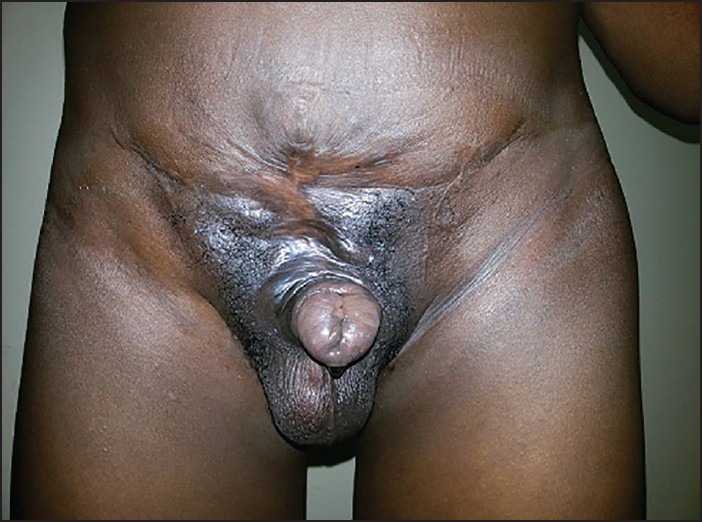
Antero Posterior view of the penis after successful initial bladder closure and successful epispadias repair contemporary in a younger of 14 years old
Figure 2.
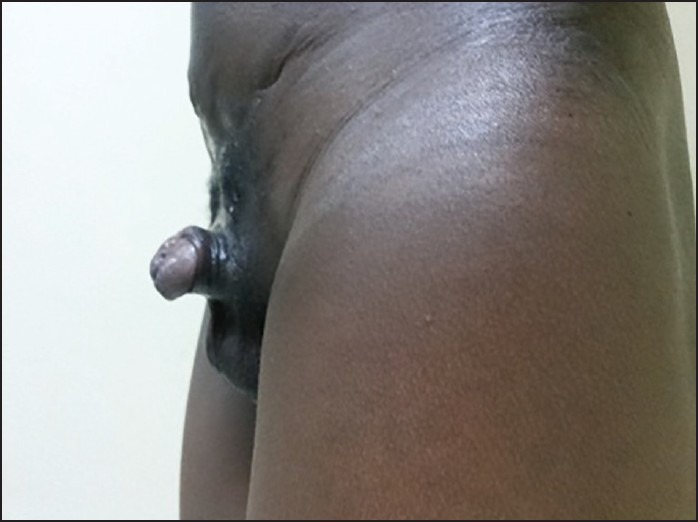
Profile view of the penis, 4 centimeters in the erection
The second patient was a female, operated in the neonatal period, she had an uneventful postoperative recoveries. In the external follow-up, she presented a vesico-cutaneous fistula [Figure 3]. The vesico-cutaneous fistula was successfully closed at the revision surgery. She had an unsightly appearance of the female external genitalia. Urinary continence could not be assessed; she did not have the age of cleanness yet.
Figure 3.
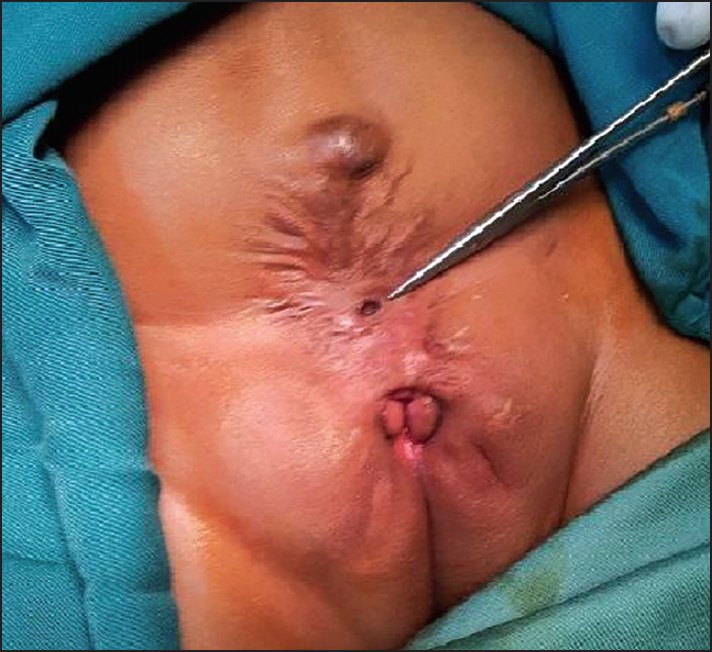
Vesico cutaneous fistula with an unsightly appearance of the female external genitalia
The third patient operated in the neonatal period, was a male. He presented the failure of the initial bladder closure with important evisceration, operated in emergency. He will have bladder closure surgical revision.
The fourth patient was operated at the age of 5½ years with an infected bladder plate. He presented a failure of initial epispadias repair due to the infected secretions from the bladder mucosa and also due to bladder pressure caused by urethral stent [Figure 4]. He had a significant urinary leakage and needs epispadias surgery revision and bladder neck reconstruction. He presented an orthopaedic complication at the left hip joint. He has a limp. He has a pelvic obliquity, varus and internal rotation of the femoral head. He has an inequality of limbs length. Pelvis radiograph shows the right osteotomy through the ilium bone, the left osteotomy through the hip joint at the acetabular roof [Figure 5].
Figure 4.
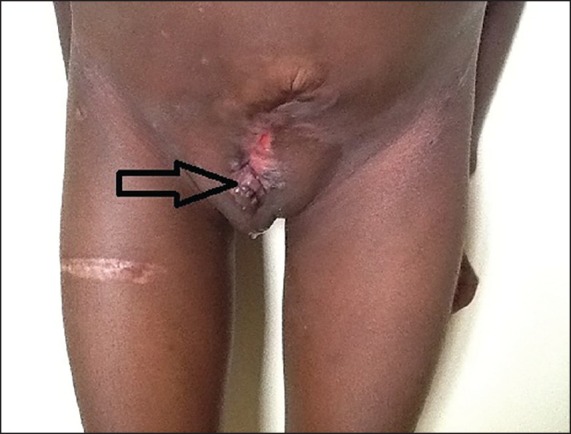
Successful initial bladder closure and failure of epispadias repair
Figure 5.
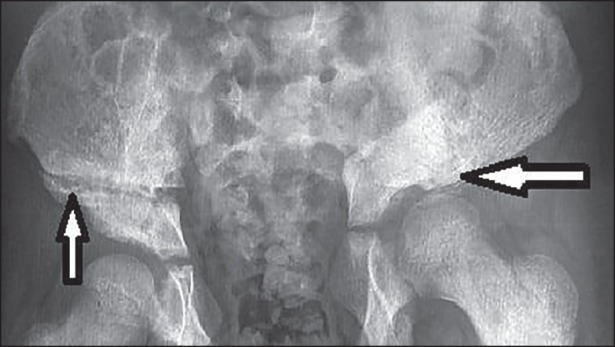
Pelvic radiograph shows the right osteotomy in the Ilium bone and the left osteotomy through the hip joint at the acetabular roof
DISCUSSION
Complications of esxtrophy bladder surgery are both more urological, orthopaedic and aesthetic than functional. A short series of four patients operated on by the same surgeon, two of them had successful initial bladder closure and one had success after revision surgery. The fourth patient presented abdominal and bladder disunion which resulted in a substantial evisceration successfully repaired urgently.
All the males had initial bladder closure with contemporary Cantwell-Ransley epispadias repair. Initial bladder closure and epispadias repair was achieved in two cases. Epispadias repair failed in one case. Failure of epispadias repair was due to infected secretion from bladder mucosa, which leads to complete urethroplasty disunion. Bladder closure was carried out on a bladder with an infected bladder plate. This patient presented a very important urinary leakage [Figure 4]. Anterior innominate osteotomy carried out has not succeeded to control the bladder leakage. We concluded that urinary continence requires a bladder closure, epispadias successfully repaired and bladder neck reconstruction. Our first patient was operated 14 years ago by the same procedure, bladder closure and epispadias repair was a success after revision surgery. Its bladder neck reconstruction was performed contemporary to bladder closure and epispadias repair. He had moderate urinary incontinence. The role of pelvic osteotomy in urinary continence was demonstrated. Pelvic osteotomy is used to facilitate bringing together pubic bones and to minimise the tension of the fused elements. Independently of the concept, there is one principle that the exstrophied bladder together with posterior urethra should be detached from the symphysis and placed deep within the pelvic ring. Assessment of continence in the patient who had vesico-cutaneous fistula was not possible because of the vesico-cutaneous fistula, especially because she had not acquired cleanness yet [Figure 3]. Achievement of urinary continence in patients with the exstrophy-epispadias complex (EEC) remains a challenge.[10,11,12,13] Persistent urinary incontinence in the patient 14 years of age could be corrected by bladder neck reconstruction according to Young Dees Leadbetter procedure. Persistent incontinence after bladder neck reconstruction is related to insufficient outlet resistance, an abnormal bladder or a combination of the two.[10] Improvement of continence is possible through bladder neck reconstruction with paraexstrophy skin flaps, but the most common complication is bladder outlet obstruction of the posterior urethra secondary to the skin flaps.[11] When, urinary incontinence persists after failure of bladder reconstruction, it is advisable to repeat bladder neck reconstruction with or without bladder augmentation or bladder neck suspension.[10] These operations can be coupled with a Mitrofanoff procedure, which offered catheterisation, if further complications occurred.[10] The fourth patient had a failure of the initial epispadias repair, giving an unsightly appearance of the penis [Figure 4]. Moreover urine leakage, epispadias revision surgery is required to give an aesthetic appearance to its external genitalia. Furthermore urological outcomes, aesthetic and functional aspects of external genitalia remains a challenge in surgery of bladder exstrophy. Long-term follow-up of patients born with classical bladder EEC reveals that many of them suffer from poor self-image, and aesthetic aspects of the genitalia and lower abdomen acquire greater significance with age.[14] Appreciation of the aesthetic outcomes of the external genitalia was possible in two patients, one male and one female. Despite the satisfying appearance of the penis [Figures 1 and 2], the adolescent and his mother requested penis enlargement. Scar of the lower abdomen was unsightly and required an umbilicoplasty. Attention to cosmetics during abdominal wall and genital reconstruction for EEC helps to improve a patient's perception of body image and self-esteem.[14,15,16] In the female, the clitoris is bipartite with an unsightly appearance of the labia majora and minora [Figure 3]. The unsightly appearance of the external genitalia may require mons plasty. Recently it has been described a simplified mons plasty. It consist in approximating the bifid hemiclitoris and subsequently incising the lateral sulci between the labia majora and minora, which allowed the superomedial rotation of the labia majora and underlying peripubic adipose tissue, thus, recreating the mons.[17] Urinary continence had not been assessed because she had not acquired her cleanliness yet. In the female initial closure is combined with reconstruction of the outer genitalia, and urinary continence can be achieved by some girls without the need for later bladder neck reconstruction.[4]
Orthopaedic complications are also described during surgery for bladder exstrophy. Whereas patients who underwent posterior pelvic osteotomy did not present orthopaedic complications, one that has undergone the anterior innominate osteotomy presented orthopaedic complications. He presented a leg length inequality, pelvic obliquity and internal rotation of the left femoral head. We plan to offset leg length inequality with orthopaedic soles. Antero-posterior pelvis radiograph shows a deformation of the left hip joint due to transacetabular osteotomy, with a moderate ascension of the femoral compared to the right side [Figure 5]. He did not complain of pain, but functional disability to walk worried the parents. Several orthopaedic complications are described in the management of bladder exstrophy. It may be nerve damage related to the osteotomy that led to the transient palsy. The most common complications include pain in the hip; unequal length of limbs, infections on external fixators used to stabilise the osteotomies.[18,19]
We stabilised pelvic osteotomy with a plaster or traction which has the benefit of preventing infectious complications described with external fixators. Immobilisation in plaster dressed in the chair position is sufficient for pelvic bones stabilisation and allows movements in the hip and knee joints.[20]
CONCLUSION
Aesthetic and functional outcomes remain a challenge in the management of bladder exstrophy. These results are related to the surgeon's experience. When, the epispadias repair is performed contemporary to initial bladder closure, its success is decisive for urinary continence. In the female, surgical revision is required after initial bladder closure for an aesthetic appearance to the external genitalia. Innominate osteotomy must be performed with brilliancy amplifier to avoid osteotomy through the hip joint to prevent inequality leg length.
Footnotes
Source of Support: Nil.
Conflict of Interest: None declared.
REFERENCES
- 1.Suominen JS, Helenius I, Taskinen S. Long-term orthopedic outcomes in patients with epispadias and bladder exstrophy. J Pediatr Surg. 2012;47:1821–4. doi: 10.1016/j.jpedsurg.2012.04.023. [DOI] [PubMed] [Google Scholar]
- 2.Deans R, Liao LM, Wood D, Woodhouse C, Creighton SM. Sexual function and health-related quality of life in women with classic bladder exstrophy. BJU Int. 2014 May 19; doi: 10.1111/bju.12811. doi: 10.1111/bju.12811. Epub ahead of print. [DOI] [PubMed] [Google Scholar]
- 3.Gupta AD, Goel SK, Woodhouse CR, Wood D. Examining long-term outcomes of bladder exstrophy: A 20-year follow-up. BJU Int. 2014;113:137–41. doi: 10.1111/bju.12389. [DOI] [PubMed] [Google Scholar]
- 4.Frimberger D, Gearhart JP, Mathews R. Female exstrophy: Failure of initial reconstruction and its implications for continence. J Urol. 2003;170:2428–31. doi: 10.1097/01.ju.0000090195.72919.f5. [DOI] [PubMed] [Google Scholar]
- 5.Meldrum KK, Baird AD, Gearhart JP. Pelvic and extremity immobilization after bladder exstrophy closure: Complications and impact on success. Urology. 2003;62:1109–13. doi: 10.1016/s0090-4295(03)00791-x. [DOI] [PubMed] [Google Scholar]
- 6.Castagnetti M, Gigante C, Perrone G, Rigamonti W. Comparison of musculoskeletal and urological functional outcomes in patients with bladder exstrophy undergoing repair with and without osteotomy. Pediatr Surg Int. 2008;24:689–93. doi: 10.1007/s00383-008-2132-x. [DOI] [PubMed] [Google Scholar]
- 7.Vining NC, Song KM, Grady RW. Classic bladder exstrophy: Orthopaedic surgical considerations. J Am Acad Orthop Surg. 2011;19:518–26. doi: 10.5435/00124635-201109000-00002. [DOI] [PubMed] [Google Scholar]
- 8.Dodson JL, Furth SL, Yenokyan G, Alcorn K, Diener-West M, Wu AW et al. Parent perspectives of health related quality of life for adolescents with bladder exstrophy-epispadias as measured by the child health questionnaire-parent form 50. J Urol. 2010;184:1656–61. doi: 10.1016/j.juro.2010.03.122. [DOI] [PMC free article] [PubMed] [Google Scholar]
- 9.Schaeffer AJ, Yenokyan G, Alcorn K, Furth SL, Diener-West M, Wu AW, Gearhart JP, Dodson JL. Health related quality of life in adolescents with bladder exstrophy-epispadias as measured by the Child Health Questionnaire-Child Form 87. J Urol. 2012;188:1924–9. doi: 10.1016/j.juro.2012.07.014. [DOI] [PMC free article] [PubMed] [Google Scholar]
- 10.Mollard P, Mouriquand PD, Buttin X. Urinary continence after reconstruction of classical bladder exstrophy (73 cases) Br J Urol. 1994;73:298–302. doi: 10.1111/j.1464-410x.1994.tb07522.x. [DOI] [PubMed] [Google Scholar]
- 11.Surer I, Baker LA, Jeffs RD, Gearhart JP. Modified Young-Dees-Leadbetter bladder neck reconstruction in patients with successful primary bladder closure elsewhere: A single institution experience. J Urol. 2001;165:2438–40. doi: 10.1016/S0022-5347(05)66224-6. [DOI] [PubMed] [Google Scholar]
- 12.Surer I, Baker LA, Jeffs RD, Gearhart JP. Combined bladder neck reconstruction and epispadias repair for exstrophy-epispadias complex. J Urol. 2001;165:2425–7. doi: 10.1016/S0022-5347(05)66220-9. [DOI] [PubMed] [Google Scholar]
- 13.Mathews R, Sponseller PD, Jeffs RD, Gearhart JP. Bladder neck reconstruction in classic bladder exstrophy: The role of osteotomy in the development of continence. BJU Int. 2000;85:498–500. doi: 10.1046/j.1464-410x.2000.00517.x. [DOI] [PubMed] [Google Scholar]
- 14.VanderBrink BA, Stock JA, Hanna MK. Aesthetic aspects of abdominal wall and external genital reconstructive surgery in bladder exstrophy-epispadias complex. Curr Urol Rep. 2006;7:149–58. doi: 10.1007/s11934-006-0075-0. [DOI] [PubMed] [Google Scholar]
- 15.Okubadejo GO, Sponseller PD, Gearhart JP. Complications in orthopedic management of exstrophy. J Pediatr Orthop. 2003;23:522–8. [PubMed] [Google Scholar]
- 16.Kantor R, Salai M, Ganel A. Orthopaedic long term aspects of bladder exstrophy. Clin Orthop Relat Res. 1997;335:240–5. [PubMed] [Google Scholar]
- 17.Cook AJ, Farhat WA, Cartwright LM, Khoury AE, Pippi Salle JL. Simplified mons plasty: A new technique to improve cosmesis in females with the exstrophy-epispadias complex. J Urol. 2005;173:2117–20. doi: 10.1097/01.ju.0000157687.37406.d8. [DOI] [PubMed] [Google Scholar]
- 18.Jones D, Parkinson S, Hosalkar HS. Oblique pelvic osteotomy in the exstrophy/epispadias complex. J Bone Joint Surg Br. 2006;88:799–806. doi: 10.1302/0301-620X.88B6.17712. [DOI] [PubMed] [Google Scholar]
- 19.Frey P. Bilateral anterior pubic osteotomy in bladder exstrophy closure. J Urol. 1996;156:812–5. doi: 10.1097/00005392-199608001-00072. [DOI] [PubMed] [Google Scholar]
- 20.Baka-Ostrowska M, Kowalczyk K, Felberg K, Wawer Z. Complications after primary bladder exstrophy closure - role of pelvic osteotomy. Cent European J Urol. 2013;66:104–8. doi: 10.5173/ceju.2013.01.art31. [DOI] [PMC free article] [PubMed] [Google Scholar]


